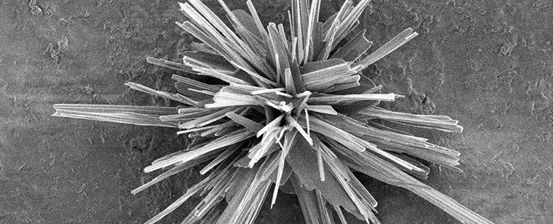将CO2转化成塑料?或许行得通!| Nature Catalysts 论文推荐
撰文 DAVID NIELD
翻译 卓思琪
审校 严冰冰
铜催化剂的表面(Canadian Light Source)
如众周知,越来越多的二氧化碳(CO2)富集于地球大气层内,使得温室效应日益加重。不过如今,科学家们为这些过多的 CO2 找到了新的出路——将它们转化成塑料。
塑料本身算不上是一种环保材料,但是,将 CO2转化至塑料中不仅拥有的了实用价值,还能减少使用制造塑料所需要的化石燃料,帮助阻止气候变化。目前最有效的做法是先将 CO2先转化为乙烯,然后以乙烯为原材料制作最为普通的塑料——聚乙烯。
这让 CO2塑料转换体系的实现更近了一步。
“我认为,未来技术会更多的‘变废为宝’,”加拿大多伦多大学的 Phil De Luna 说道,“而开发这条可持续新能源道路以满足未来的能量需求,十分令人兴奋。”
研究团队利用X射线光谱学、电脑建模技术等,在萨斯喀彻温大学的加拿大国家光源(CLS)进行了分析研究:通过电磁辐射寻找关键的催化剂。
得益于资深科学家 Tom Regier 开发的 CLS 的新设施,研究者们可以实时地研究研究催化剂的形状和化学环境。
同样来自多伦多大学的 Rafael Quintero-Bermudez 说道:“目前为止还没有人做过这样的研究。这项独特的检测技术让我们可以深入研究催化过程是如何发生的,以及如何优化设计该过程。”
De Luna 还补充说道:“这项实验在世界上其他的实验室都无法完成,而实验结果使我们感到十分兴奋。”
当催化剂被一束电流击中时,它可以驱动 CO2还原反应、将 CO2转化为其他化学材料。许多金属可被用作催化剂,但铜是唯一已知可用于催化生成乙烯的金属。
科学家们研究出了该转化反应的控制系统,旨在产生最大量的乙烯的同时,产生最少的‘废物’(如甲烷)。
De Luna 说道:“铜像是一种带有‘魔法’的金属,因为它可以催化生成许多不同的化学物质,但问题是想要控制它催化生成什么却很困难。”
凭借这项全新的知识和适合的碳捕捉技术,研究者们也许可以在消除 CO2的同时,以环保方式生产塑料。
只要这项转化技术所需的能源是可再生的、生产的塑料在未来能被循环利用,那么整体上会带来积极的影响。
目前每年的聚乙烯产量已经超过了1亿吨,这项新技术可以使我们的大气质量有显著的改善。优化这项技术还需要进一步的研究,但是目前我们已经有了一个很好的基础。
值得一提的是,科学家们曾几近放弃这项研究。
“我们曾想要放弃,但是当结果出现时,它让我们心头一震。”Quintero-Bermudez 说道:“这是个非常漂亮、非常鼓舞人心的结果。”
该项发现被发表在了 Nature Catalysts 上。(论文信息见文末)
【原文地址】https://www.sciencealert.com/scientists-plan-to-recycle-waste-carbon-dioxide-co2-into-plastic
相关论文信息
【论文题目】Catalyst electro-redeposition controls morphology and oxidationstate for selective carbon dioxide reduction
【作者】Phil De Luna, Edward H. Sargent et al.
【期刊】Nature Catalysts
【DOI】10.1038/s41929-017-0018-9
【摘要】The reduction of carbon dioxide to renewable fuels and feedstocksoffers opportunities for large-scale, long-term energy storage. The synthesisof efficient CO2 reduction electrocatalysts with high C2:C1selectivity remains a field of intense interest. Here we presentelectro-redeposition, the dissolution and redeposition of copper from a sol–gel, to enhance copper catalysts in terms of their morphology,oxidation state and consequent performance. We utilized in situ soft X-rayabsorption spectroscopy to track the oxidation state of copper under CO2 reductionconditions with time resolution. The sol–gel materialslows the electrochemical reduction of copper, enabling control over nanoscalemorphology and the stabilization of Cu+ at negative potentials.CO2 reduction experiments, in situ X-ray spectroscopy anddensity functional theory simulations revealed the beneficial interplay betweensharp morphologies and Cu+ oxidation state. The catalystexhibits a partial ethylene current density of 160 mA cm–2 (−1.0 V versus reversible hydrogen electrode) and an ethylene/methaneratio of 200.
【论文地址】https://www.nature.com/articles/s41929-017-0018-9
阅读更多
▽ 故事
· Sci-Hub背后的“盗版女王”:只要人身安全,就会坚持下去
· “2017年度学术公众号”TOP 10重磅发布 | 科研圈出品
· 解答奖金100万美元!你敢挑战这个物理学最难的方程之一吗?
▽ 论文推荐
· 吴岳良院士专访:太极计划与中国引力波研究 | NSR访谈
▽ 论文导读
内容合作请联系
keyanquan@huanqiukexue.com






